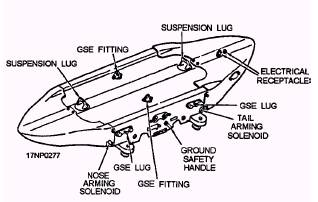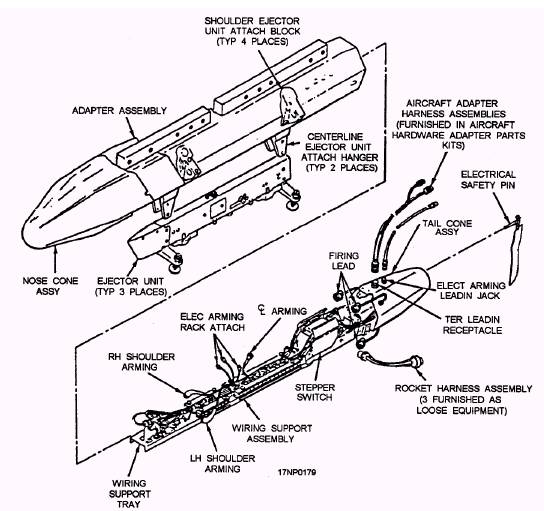BRU-33/A AND BRU-33A/A VERTICAL EJECTOR RACK
The BRU-33 vertical ejector rack (VER) (fig. 10-20) is suspended by the BRU-32/A bomb rack. It provides side-by-side and canted side-by-side carriage and release of two 14-inch suspension stores, ranging from 10- to 16-inches in diameter and weighing up to 1,000 pounds. The ejector racks provide automatic swaybracing through the use of spring loaded, self-adjusting wedges. The safety interlock is electrically controlled by the aircraft and mechanically prevents accidental opening of the suspension hooks.
Sensing switches are incorporated to indicate to the SMP that a store is loaded. The rack has provisions for mechanical and electric
fuzing. The ejection unit uses two cartridges to generate the required gas pressure for
rack operations.

Figure 10-20.-BRU-33/A bomb ejector rack.
For further information concerning the BRU-33 vertical ejector rack, refer to the publication AW-382AC-750-010, Vertical Ejector Rack Assembly BRU-33/A and BRU-33A/A,
A/A37B-6E MULTIPLE EJECTOR RACK (MER) AND A/A37B-5E TRIPLE EJECTOR RACK (TER)
The A/A37B-6E multiple ejector rack (MER) (fig. 10-21) and the A/A37B-5E triple ejector rack

Figure 10-21.-Multiple ejector rack, exploded view.

Figure 10-22.-Triple ejector rack, exploded view.
(TER) (fig. 10-22) are known as a MER or TER. They are essentially the same assemblies except for structural size and the number of stores they can carry. The MER and TER are classified as accessory racks. They are installed on parent bomb racks or pylons to increase the number of stores that can be suspended by a particular station.
Both the MER and TER consist of three major subassemblies-an adapter assembly, a wiring support assembly, and three ejector units for the TER and six ejector units for the MER.

Figure 10-23.-BRU-41/A IMER.

